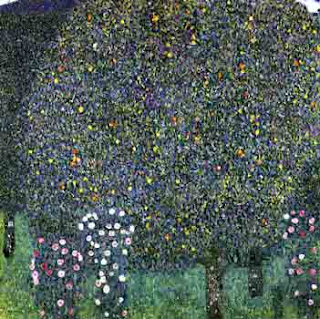It was a foggy day on Lake Attersee, so Gustav Klimt couldn’t see across the water through that telescope. We know that he used the telescope to frame the elegantly untethered landscapes he painted. He was not being serious about looking on this particular occasion, his face turned slightly toward the photographer. If we didn’t know about his vanity, we could intuit it from the cumberbund he is wearing that accentuates the barrel shape he acquired in middle age more than it restrains it.
Lake Attersee, situated in western Austria, is far removed from the hectic life of the capitol city. Not that Klimt didn't enjoy being over-stimulated but, away from the distractions of so many attractive Viennese women, the artist found an atmosphere conducive to working with landscape. Both sublime and subliminally inspiring is the famed Rosenwind, an easterly wind off Lake Attersee that carries the fragrance of a thousand roses from a castle garden, perfuming the air with magic.
When I visited the Klimt landscape exhibition at the Clark Art Institute I saw Arthur Schopenhauer's idea of nature's chaos brought under the control of art. From close up, Klimt's brushstrokes appear abstract but back off and they represent flowers, trees, and water (but seldom sky) while remaining noncommittal, a very loose form of verisimilitude indeed.

Buildings inhabit space almost as an afterthought, as though these gardens were not also human creations. The orderly looking farmhouse seems no match for its surroundings, a Freudian image of emotion's triumph over reason. Klimt's attitudes toward nature, human and otherwise, were pessimistic and regressive. He wrote once that he yearned to find a place where "fate will allow us to enjoy our pleasure." This from a man whose self-indulgence needed more than a cumberbund to restrain it.
When I visited the Klimt landscape exhibition at the Clark Art Institute I saw Arthur Schopenhauer's idea of nature's chaos brought under the control of art. From close up, Klimt's brushstrokes appear abstract but back off and they represent flowers, trees, and water (but seldom sky) while remaining noncommittal, a very loose form of verisimilitude indeed.

Buildings inhabit space almost as an afterthought, as though these gardens were not also human creations. The orderly looking farmhouse seems no match for its surroundings, a Freudian image of emotion's triumph over reason. Klimt's attitudes toward nature, human and otherwise, were pessimistic and regressive. He wrote once that he yearned to find a place where "fate will allow us to enjoy our pleasure." This from a man whose self-indulgence needed more than a cumberbund to restrain it.

Gustav Klimt Landscapes was one of four exhibitions at the Sterling and Francine Clark Art Institute (other displayed the works of architects Otto Wagner and Josef Hoffmann and the painter Bernardo Bellotto) were part of the Vienna Project at eleven institutions of art, music, and theater in Massachusetts during the summer of 2002.
1. unidentified photographer - Gustav Klimt and his telescope, c.1905, courtesy Clark Art Institue, Williamstown, MA.
2. Gustav Klimt - Italian Garden, 1913, Kunsthaus Zug/Foundation Kamm Collection, Switzerland.
3. Gustav Klimt - Fruit Orchard With Roses, c. 1911, courtesy Clark Art Institute. Williamstown, MA.
4. Gustav Klimt - Roses Under the Trees, 1905, Musee d'Orsay, Paris. (to be restored to its original owners who sold it the Nazis under duress - March, 2021)
5. Gustav Klimt - Farmhouse with Birch Trees, 1911, Belvedere Galerie, Vienna.
6. Gustav Klimt - Forest Slope in Unterach on the Attersee, 1916, private collection, courtesy Clark Art Institute,





8 comments:
There's something about Klimt that bothers me, but than I really don't care for any of the pointillist work. It's just too claustrophobic for my mind to handle it.
Dear Jane, your blog is a treasure!
Thank you!!!
Elegantly untethered - I like that so much!
Thanks, Towanda. You have company because many people have found Klimt's work unsettling - for any number of reasons.
Eduardo, to have readers and to have them enjoy what they find here is a gift. I thank you.
The mention of Photography and Japanese art certainly brings to mind the work of Arthur Wesley Dow and his woodcuts and cyanotype photography, but Dow certainly took his art in a different direction than Klimt. Interesting posting...thanks for what you do!
Neil, when I chose untethered I was thinking how the sky and/or the horizon get(s) short shrift in Klimt's landscapes. Also, how disorienting it is to look at ordinary objects with an unusual optic magnitude. The word elegant was meant as a tribute to how the results look, how the eye is drawn into the paintings and finds there a satisfying composition in nature (imposed by the artist?).
Great to see Klimt's work...he is one of my favorite artists!
Post a Comment